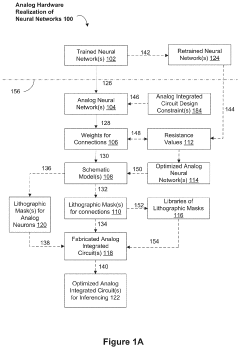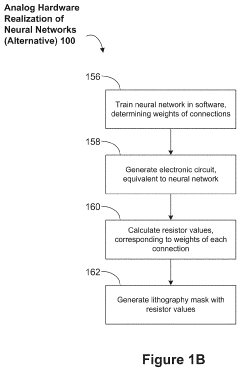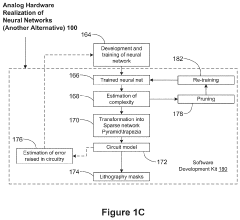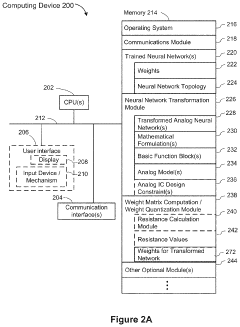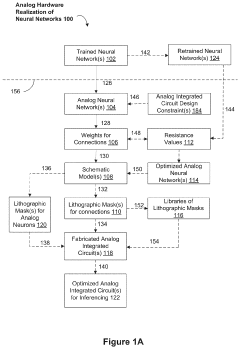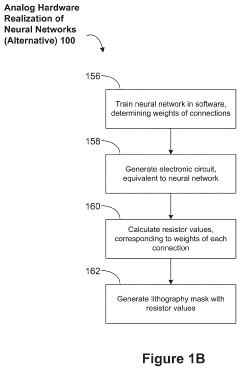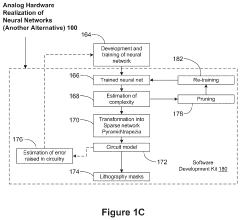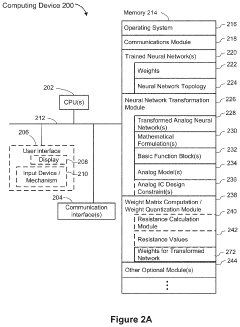Neuromorphic Chips for Edge AI: Use Cases in IoT, Wearables and Drones
OCT 9, 20259 MIN READ
Generate Your Research Report Instantly with AI Agent
Patsnap Eureka helps you evaluate technical feasibility & market potential.
Neuromorphic Chip Evolution and Objectives
Neuromorphic computing, inspired by the structure and function of biological neural networks, has evolved significantly over the past few decades. The concept originated in the late 1980s with Carver Mead's pioneering work on analog VLSI implementations of neural systems. Since then, the field has progressed through various stages, each marked by technological advancements and expanding applications.
In the early 2000s, researchers began developing more sophisticated neuromorphic architectures, such as IBM's TrueNorth chip and the University of Heidelberg's BrainScaleS project. These efforts aimed to create large-scale systems that could more closely mimic the brain's parallel processing capabilities and energy efficiency.
The current generation of neuromorphic chips, exemplified by Intel's Loihi and BrainChip's Akida, represents a significant leap forward in terms of scale, efficiency, and practical applicability. These chips are designed to excel in edge AI applications, where low power consumption and real-time processing are critical.
The evolution of neuromorphic chips has been driven by the increasing demand for AI capabilities in edge devices, particularly in the Internet of Things (IoT), wearables, and drones. These applications require AI processing that is not only powerful but also energy-efficient and capable of operating in real-time with minimal latency.
The primary objectives of current neuromorphic chip development for edge AI focus on several key areas. First, there is a push to improve energy efficiency, aiming to enable AI processing with power consumption orders of magnitude lower than traditional von Neumann architectures. This is crucial for battery-powered devices and energy-constrained environments.
Second, researchers are working to enhance the chips' ability to perform online learning and adaptation. This would allow edge devices to continuously improve their performance and adapt to new situations without requiring constant retraining or updates from centralized servers.
Third, there is a focus on increasing the scale and complexity of neuromorphic systems while maintaining their efficiency advantages. This involves developing new materials, manufacturing processes, and architectural designs that can support larger networks of artificial neurons and synapses.
Finally, a key objective is to improve the integration of neuromorphic chips with conventional computing systems and software frameworks. This includes developing tools and interfaces that make it easier for developers to harness the unique capabilities of neuromorphic hardware in practical applications.
As the field progresses, the ultimate goal is to create neuromorphic systems that can approach the human brain's remarkable ability to process complex sensory information, learn from experience, and make decisions in real-time, all while consuming minimal power. This vision, if realized, could revolutionize edge AI applications across numerous industries and domains.
In the early 2000s, researchers began developing more sophisticated neuromorphic architectures, such as IBM's TrueNorth chip and the University of Heidelberg's BrainScaleS project. These efforts aimed to create large-scale systems that could more closely mimic the brain's parallel processing capabilities and energy efficiency.
The current generation of neuromorphic chips, exemplified by Intel's Loihi and BrainChip's Akida, represents a significant leap forward in terms of scale, efficiency, and practical applicability. These chips are designed to excel in edge AI applications, where low power consumption and real-time processing are critical.
The evolution of neuromorphic chips has been driven by the increasing demand for AI capabilities in edge devices, particularly in the Internet of Things (IoT), wearables, and drones. These applications require AI processing that is not only powerful but also energy-efficient and capable of operating in real-time with minimal latency.
The primary objectives of current neuromorphic chip development for edge AI focus on several key areas. First, there is a push to improve energy efficiency, aiming to enable AI processing with power consumption orders of magnitude lower than traditional von Neumann architectures. This is crucial for battery-powered devices and energy-constrained environments.
Second, researchers are working to enhance the chips' ability to perform online learning and adaptation. This would allow edge devices to continuously improve their performance and adapt to new situations without requiring constant retraining or updates from centralized servers.
Third, there is a focus on increasing the scale and complexity of neuromorphic systems while maintaining their efficiency advantages. This involves developing new materials, manufacturing processes, and architectural designs that can support larger networks of artificial neurons and synapses.
Finally, a key objective is to improve the integration of neuromorphic chips with conventional computing systems and software frameworks. This includes developing tools and interfaces that make it easier for developers to harness the unique capabilities of neuromorphic hardware in practical applications.
As the field progresses, the ultimate goal is to create neuromorphic systems that can approach the human brain's remarkable ability to process complex sensory information, learn from experience, and make decisions in real-time, all while consuming minimal power. This vision, if realized, could revolutionize edge AI applications across numerous industries and domains.
Edge AI Market Demand Analysis
The demand for Edge AI solutions, particularly those leveraging neuromorphic chips, is experiencing significant growth across various IoT, wearable, and drone applications. This surge is driven by the increasing need for real-time data processing, reduced latency, and enhanced privacy in edge devices.
In the IoT sector, neuromorphic chips for Edge AI are finding applications in smart homes, industrial automation, and smart cities. These chips enable devices to process sensor data locally, reducing the need for constant cloud connectivity and improving response times. For instance, in smart home systems, neuromorphic chips can enhance the performance of voice assistants and security cameras, providing faster and more accurate responses to user commands and potential security threats.
The wearables market is another key driver for neuromorphic Edge AI chips. As consumers demand more sophisticated health monitoring and augmented reality features in their smartwatches and fitness trackers, the need for efficient, low-power AI processing becomes crucial. Neuromorphic chips can enable advanced features such as real-time health anomaly detection, natural language processing for voice commands, and gesture recognition, all while maintaining extended battery life.
In the drone industry, neuromorphic chips are revolutionizing autonomous flight capabilities and on-board image processing. These chips allow drones to navigate complex environments, avoid obstacles, and make split-second decisions without relying on cloud connectivity. This is particularly valuable in applications such as search and rescue operations, agricultural monitoring, and infrastructure inspection, where real-time processing and decision-making are critical.
The market demand for neuromorphic Edge AI chips is also being fueled by the growing concerns over data privacy and security. By processing sensitive data locally on the device, these chips reduce the need to transmit personal information to the cloud, addressing privacy concerns in applications such as facial recognition and voice analysis.
Furthermore, the push towards 5G networks is expected to accelerate the adoption of Edge AI solutions. As 5G enables faster and more reliable connections, it will create new opportunities for edge devices to leverage cloud resources while still maintaining the benefits of local processing. This hybrid approach will likely drive further innovation in neuromorphic chip design and Edge AI applications.
In the IoT sector, neuromorphic chips for Edge AI are finding applications in smart homes, industrial automation, and smart cities. These chips enable devices to process sensor data locally, reducing the need for constant cloud connectivity and improving response times. For instance, in smart home systems, neuromorphic chips can enhance the performance of voice assistants and security cameras, providing faster and more accurate responses to user commands and potential security threats.
The wearables market is another key driver for neuromorphic Edge AI chips. As consumers demand more sophisticated health monitoring and augmented reality features in their smartwatches and fitness trackers, the need for efficient, low-power AI processing becomes crucial. Neuromorphic chips can enable advanced features such as real-time health anomaly detection, natural language processing for voice commands, and gesture recognition, all while maintaining extended battery life.
In the drone industry, neuromorphic chips are revolutionizing autonomous flight capabilities and on-board image processing. These chips allow drones to navigate complex environments, avoid obstacles, and make split-second decisions without relying on cloud connectivity. This is particularly valuable in applications such as search and rescue operations, agricultural monitoring, and infrastructure inspection, where real-time processing and decision-making are critical.
The market demand for neuromorphic Edge AI chips is also being fueled by the growing concerns over data privacy and security. By processing sensitive data locally on the device, these chips reduce the need to transmit personal information to the cloud, addressing privacy concerns in applications such as facial recognition and voice analysis.
Furthermore, the push towards 5G networks is expected to accelerate the adoption of Edge AI solutions. As 5G enables faster and more reliable connections, it will create new opportunities for edge devices to leverage cloud resources while still maintaining the benefits of local processing. This hybrid approach will likely drive further innovation in neuromorphic chip design and Edge AI applications.
Neuromorphic Computing Challenges
Neuromorphic computing, while promising, faces several significant challenges that hinder its widespread adoption and implementation in edge AI applications for IoT, wearables, and drones. One of the primary obstacles is the scalability of neuromorphic hardware. Current neuromorphic chips struggle to match the performance and efficiency of traditional von Neumann architectures at larger scales, limiting their applicability in complex AI tasks.
Power consumption remains a critical issue, particularly for edge devices with limited energy resources. Although neuromorphic chips aim to mimic the energy efficiency of biological brains, achieving comparable levels of power efficiency while maintaining high performance is still a considerable challenge. This is especially crucial for battery-powered IoT devices and wearables that require long operational times.
The lack of standardized programming models and development tools poses another significant hurdle. Unlike traditional computing paradigms, neuromorphic systems require specialized programming approaches that can effectively leverage their unique architecture. The absence of widely accepted standards and user-friendly development environments makes it difficult for developers to create and optimize applications for neuromorphic hardware.
Reliability and fault tolerance are also major concerns in neuromorphic computing. As these systems often rely on analog components and novel materials, they can be more susceptible to environmental factors and manufacturing variations. Ensuring consistent performance across different devices and operating conditions is crucial for their adoption in critical applications such as autonomous drones.
Integration with existing systems and workflows presents another challenge. Many organizations have invested heavily in traditional AI infrastructure and software stacks. Transitioning to neuromorphic computing requires significant changes in hardware, software, and development practices, which can be costly and time-consuming.
The limited availability of large-scale neuromorphic hardware for testing and development further impedes progress. Researchers and developers often lack access to state-of-the-art neuromorphic systems, making it difficult to validate algorithms and applications at scale. This bottleneck slows down the overall development and adoption of neuromorphic computing in real-world scenarios.
Addressing the challenge of real-time learning and adaptation is crucial for edge AI applications. While neuromorphic systems show promise in this area, developing efficient online learning algorithms that can operate within the constraints of edge devices remains an active area of research. This is particularly important for applications in dynamic environments, such as drones navigating changing landscapes or IoT devices adapting to evolving user behaviors.
Power consumption remains a critical issue, particularly for edge devices with limited energy resources. Although neuromorphic chips aim to mimic the energy efficiency of biological brains, achieving comparable levels of power efficiency while maintaining high performance is still a considerable challenge. This is especially crucial for battery-powered IoT devices and wearables that require long operational times.
The lack of standardized programming models and development tools poses another significant hurdle. Unlike traditional computing paradigms, neuromorphic systems require specialized programming approaches that can effectively leverage their unique architecture. The absence of widely accepted standards and user-friendly development environments makes it difficult for developers to create and optimize applications for neuromorphic hardware.
Reliability and fault tolerance are also major concerns in neuromorphic computing. As these systems often rely on analog components and novel materials, they can be more susceptible to environmental factors and manufacturing variations. Ensuring consistent performance across different devices and operating conditions is crucial for their adoption in critical applications such as autonomous drones.
Integration with existing systems and workflows presents another challenge. Many organizations have invested heavily in traditional AI infrastructure and software stacks. Transitioning to neuromorphic computing requires significant changes in hardware, software, and development practices, which can be costly and time-consuming.
The limited availability of large-scale neuromorphic hardware for testing and development further impedes progress. Researchers and developers often lack access to state-of-the-art neuromorphic systems, making it difficult to validate algorithms and applications at scale. This bottleneck slows down the overall development and adoption of neuromorphic computing in real-world scenarios.
Addressing the challenge of real-time learning and adaptation is crucial for edge AI applications. While neuromorphic systems show promise in this area, developing efficient online learning algorithms that can operate within the constraints of edge devices remains an active area of research. This is particularly important for applications in dynamic environments, such as drones navigating changing landscapes or IoT devices adapting to evolving user behaviors.
Current Neuromorphic Solutions for Edge AI
01 Architecture and design of neuromorphic chips
Neuromorphic chips are designed to mimic the structure and function of biological neural networks. These chips incorporate specialized circuits and components that emulate neurons and synapses, allowing for parallel processing and efficient handling of complex cognitive tasks. The architecture often includes analog or mixed-signal circuits to replicate the continuous nature of biological neural networks.- Architecture and design of neuromorphic chips: Neuromorphic chips are designed to mimic the structure and function of biological neural networks. These chips incorporate specialized hardware components that emulate neurons and synapses, allowing for parallel processing and efficient computation of neural network algorithms. The architecture often includes analog or mixed-signal circuits to replicate the continuous-time dynamics of biological neurons.
- Learning and adaptation mechanisms in neuromorphic systems: Neuromorphic chips implement various learning algorithms and adaptation mechanisms inspired by biological neural networks. These may include spike-timing-dependent plasticity (STDP), reinforcement learning, and unsupervised learning techniques. The chips are designed to modify their internal parameters and connections based on input data, enabling them to learn and adapt to new information over time.
- Integration of neuromorphic chips with conventional computing systems: Neuromorphic chips are often designed to interface with traditional computing systems, allowing for hybrid architectures that combine the strengths of both neuromorphic and conventional processors. This integration enables efficient processing of neural network algorithms while maintaining compatibility with existing software and hardware ecosystems.
- Energy efficiency and low-power operation of neuromorphic chips: A key feature of neuromorphic chips is their ability to perform complex computations with high energy efficiency. These chips often utilize low-power design techniques, such as asynchronous circuits and event-driven processing, to minimize power consumption while maintaining high performance in neural network computations.
- Applications and use cases for neuromorphic computing: Neuromorphic chips find applications in various domains, including computer vision, natural language processing, robotics, and autonomous systems. These chips are particularly well-suited for tasks that require real-time processing of sensory data, pattern recognition, and decision-making in dynamic environments. They offer potential advantages in terms of speed, power efficiency, and adaptability compared to traditional computing approaches.
02 Learning and adaptation mechanisms in neuromorphic systems
Neuromorphic chips implement various learning algorithms and adaptation mechanisms inspired by biological neural networks. These include spike-timing-dependent plasticity (STDP), reinforcement learning, and unsupervised learning techniques. The chips can dynamically adjust synaptic weights and neural connections based on input patterns and feedback, enabling continuous learning and adaptation to new information.Expand Specific Solutions03 Integration of neuromorphic chips with conventional computing systems
Neuromorphic chips are designed to work in conjunction with traditional computing systems, creating hybrid architectures that leverage the strengths of both neuromorphic and conventional processing. This integration allows for efficient handling of both cognitive tasks and traditional computational operations, enabling new applications in areas such as robotics, autonomous systems, and intelligent sensors.Expand Specific Solutions04 Energy efficiency and low-power operation of neuromorphic chips
Neuromorphic chips are designed for high energy efficiency and low-power operation, inspired by the energy efficiency of biological brains. These chips often utilize event-driven processing, where computations are performed only when necessary, and incorporate novel materials and circuit designs to minimize power consumption while maintaining high performance in cognitive tasks.Expand Specific Solutions05 Applications and use cases for neuromorphic computing
Neuromorphic chips find applications in various fields, including computer vision, natural language processing, autonomous systems, and brain-computer interfaces. These chips excel in tasks that require real-time processing of sensory data, pattern recognition, and decision-making in complex environments. They are particularly suited for edge computing applications where low power consumption and high-speed processing are critical.Expand Specific Solutions
Key Neuromorphic Chip Manufacturers
The neuromorphic chips for edge AI market is in its early growth stage, with increasing applications in IoT, wearables, and drones. The market size is expanding rapidly, driven by demand for low-power, high-performance AI processing at the edge. While the technology is still maturing, several key players are making significant advancements. Companies like Intel, IBM, and Samsung are leveraging their semiconductor expertise to develop neuromorphic solutions. Startups such as Syntiant and BrainChip are also emerging as innovators in this space. As the technology evolves, we can expect to see more specialized chips optimized for specific edge AI use cases across various industries.
International Business Machines Corp.
Technical Solution: IBM's neuromorphic chip technology, TrueNorth, is designed for edge AI applications in IoT, wearables, and drones. The chip's architecture mimics the human brain's neural networks, featuring a million programmable neurons and 256 million synapses[1]. TrueNorth consumes only 70 milliwatts of power while performing 46 billion synaptic operations per second, making it highly energy-efficient for edge computing[2]. IBM has demonstrated TrueNorth's capabilities in real-time object recognition, natural language processing, and complex decision-making tasks, which are crucial for IoT devices, smart wearables, and autonomous drones[3]. The chip's event-driven, parallel processing nature allows for rapid, low-latency responses, essential for real-time applications in edge AI scenarios[4].
Strengths: Extremely low power consumption, high-speed parallel processing, and scalability for complex AI tasks. Weaknesses: Requires specialized programming paradigms and may have limited compatibility with traditional AI algorithms.
Syntiant Corp.
Technical Solution: Syntiant specializes in ultra-low-power AI processors for edge devices, particularly focusing on always-on applications in IoT and wearables. Their Neural Decision Processors (NDPs) utilize a neuromorphic architecture optimized for deep learning inference at the edge[5]. The NDP100 and NDP101 chips can perform wake word detection, speaker identification, and other audio processing tasks while consuming less than 140 microwatts[6]. For IoT applications, Syntiant's chips enable voice-controlled smart home devices, battery-operated sensors, and intelligent monitoring systems. In wearables, the technology powers always-on health monitoring, gesture recognition, and voice-activated controls. The company has also explored applications in drones for on-device decision making and obstacle avoidance[7].
Strengths: Extremely low power consumption, ideal for battery-operated devices, and specialized for audio AI tasks. Weaknesses: Limited to specific AI applications, primarily focused on audio processing.
Core Neuromorphic Innovations
Neuromorphic Analog Signal Processor for Predictive Maintenance of Machines
PatentPendingUS20230081715A1
Innovation
- Analog neuromorphic circuits that model trained neural networks, using operational amplifiers and resistors to create hardware implementations that are more power-efficient, scalable, and less sensitive to noise and temperature changes, allowing for mass production and reduced manufacturing costs.
Systems and Methods for Human Activity Recognition Using Analog Neuromorphic Computing Hardware
PatentPendingUS20220280072A1
Innovation
- Analog neuromorphic circuits that model trained neural networks, allowing for improved performance per watt, reduced power consumption, and cost-effective manufacturing, with the ability to distinguish multiple human activities and provide personalized solutions, by transforming neural network topologies into equivalent analog networks using operational amplifiers and resistors, enabling mass production and efficient retraining.
Energy Efficiency in Edge AI Devices
Energy efficiency is a critical factor in the development and deployment of edge AI devices, particularly in the context of neuromorphic chips for IoT, wearables, and drones. These devices often operate in resource-constrained environments, making power consumption a key consideration for their practical implementation and widespread adoption.
Neuromorphic chips, designed to mimic the structure and function of biological neural networks, offer significant advantages in terms of energy efficiency compared to traditional von Neumann architectures. By processing information in a manner similar to the human brain, these chips can perform complex AI tasks with substantially lower power consumption.
In IoT applications, energy-efficient neuromorphic chips enable the deployment of intelligent sensors and devices in remote or hard-to-reach locations. These chips can perform local data processing and decision-making, reducing the need for constant communication with centralized servers and thus conserving battery life. This is particularly crucial for applications such as environmental monitoring, smart agriculture, and industrial IoT, where frequent battery replacements are impractical or costly.
For wearable devices, energy efficiency directly impacts user experience and device functionality. Neuromorphic chips allow for more sophisticated AI capabilities, such as real-time health monitoring, gesture recognition, and personalized assistance, without significantly compromising battery life. This balance between performance and power consumption is essential for the widespread adoption of AI-enabled wearables in healthcare, fitness, and consumer electronics sectors.
In the realm of drones, energy-efficient neuromorphic chips play a vital role in extending flight times and enhancing autonomous capabilities. By reducing the power required for onboard AI processing, these chips allow drones to operate for longer periods, cover greater distances, and perform more complex tasks such as object recognition, navigation, and decision-making in real-time.
The energy efficiency of neuromorphic chips in edge AI devices is achieved through several key mechanisms. Firstly, their event-driven processing nature allows for significant power savings by activating computational resources only when necessary. Secondly, the co-location of memory and processing elements reduces energy-intensive data movement. Lastly, the inherent parallelism of neuromorphic architectures enables efficient processing of multiple inputs simultaneously, further optimizing energy consumption.
As the field of neuromorphic computing advances, we can expect to see continued improvements in energy efficiency, pushing the boundaries of what is possible in edge AI applications. This progress will likely lead to the development of even more sophisticated and capable IoT devices, wearables, and drones, opening up new possibilities for AI-driven innovation across various industries and domains.
Neuromorphic chips, designed to mimic the structure and function of biological neural networks, offer significant advantages in terms of energy efficiency compared to traditional von Neumann architectures. By processing information in a manner similar to the human brain, these chips can perform complex AI tasks with substantially lower power consumption.
In IoT applications, energy-efficient neuromorphic chips enable the deployment of intelligent sensors and devices in remote or hard-to-reach locations. These chips can perform local data processing and decision-making, reducing the need for constant communication with centralized servers and thus conserving battery life. This is particularly crucial for applications such as environmental monitoring, smart agriculture, and industrial IoT, where frequent battery replacements are impractical or costly.
For wearable devices, energy efficiency directly impacts user experience and device functionality. Neuromorphic chips allow for more sophisticated AI capabilities, such as real-time health monitoring, gesture recognition, and personalized assistance, without significantly compromising battery life. This balance between performance and power consumption is essential for the widespread adoption of AI-enabled wearables in healthcare, fitness, and consumer electronics sectors.
In the realm of drones, energy-efficient neuromorphic chips play a vital role in extending flight times and enhancing autonomous capabilities. By reducing the power required for onboard AI processing, these chips allow drones to operate for longer periods, cover greater distances, and perform more complex tasks such as object recognition, navigation, and decision-making in real-time.
The energy efficiency of neuromorphic chips in edge AI devices is achieved through several key mechanisms. Firstly, their event-driven processing nature allows for significant power savings by activating computational resources only when necessary. Secondly, the co-location of memory and processing elements reduces energy-intensive data movement. Lastly, the inherent parallelism of neuromorphic architectures enables efficient processing of multiple inputs simultaneously, further optimizing energy consumption.
As the field of neuromorphic computing advances, we can expect to see continued improvements in energy efficiency, pushing the boundaries of what is possible in edge AI applications. This progress will likely lead to the development of even more sophisticated and capable IoT devices, wearables, and drones, opening up new possibilities for AI-driven innovation across various industries and domains.
Neuromorphic Chip Security Considerations
As neuromorphic chips gain prominence in edge AI applications for IoT, wearables, and drones, addressing security considerations becomes paramount. These chips, designed to mimic the human brain's neural networks, present unique security challenges and opportunities. One primary concern is the potential vulnerability to adversarial attacks, where malicious actors could manipulate input data to deceive the neuromorphic system. This risk is particularly acute in IoT and drone applications, where compromised decision-making could lead to severe consequences.
Data privacy is another critical issue, especially for wearable devices that process sensitive personal information. Neuromorphic chips must incorporate robust encryption mechanisms to protect data both at rest and in transit. Additionally, secure boot processes and hardware-level authentication are essential to prevent unauthorized access or tampering with the chip's firmware.
The distributed nature of neuromorphic computing introduces new attack surfaces. In IoT networks, for instance, compromised neuromorphic chips could serve as entry points for broader system infiltration. Implementing secure communication protocols and network segmentation is crucial to mitigate this risk.
Power analysis attacks pose a unique threat to neuromorphic chips due to their energy-efficient design. Attackers could potentially extract sensitive information by analyzing power consumption patterns. Countermeasures such as power randomization techniques and side-channel resistant designs must be integrated into the chip architecture.
Ensuring the integrity of learning algorithms is vital, particularly for applications that involve continuous learning at the edge. Secure update mechanisms and verifiable AI models are necessary to prevent the injection of malicious training data or unauthorized modifications to the learning process.
The use of neuromorphic chips in drones introduces additional security considerations related to physical access and remote hijacking. Robust authentication and encryption for drone control signals, along with tamper-evident hardware designs, are essential to maintain operational security.
As the field evolves, developing standardized security protocols and certification processes for neuromorphic chips will be crucial. This will ensure a consistent approach to security across different manufacturers and applications, fostering trust and wider adoption of this technology in critical edge AI deployments.
Data privacy is another critical issue, especially for wearable devices that process sensitive personal information. Neuromorphic chips must incorporate robust encryption mechanisms to protect data both at rest and in transit. Additionally, secure boot processes and hardware-level authentication are essential to prevent unauthorized access or tampering with the chip's firmware.
The distributed nature of neuromorphic computing introduces new attack surfaces. In IoT networks, for instance, compromised neuromorphic chips could serve as entry points for broader system infiltration. Implementing secure communication protocols and network segmentation is crucial to mitigate this risk.
Power analysis attacks pose a unique threat to neuromorphic chips due to their energy-efficient design. Attackers could potentially extract sensitive information by analyzing power consumption patterns. Countermeasures such as power randomization techniques and side-channel resistant designs must be integrated into the chip architecture.
Ensuring the integrity of learning algorithms is vital, particularly for applications that involve continuous learning at the edge. Secure update mechanisms and verifiable AI models are necessary to prevent the injection of malicious training data or unauthorized modifications to the learning process.
The use of neuromorphic chips in drones introduces additional security considerations related to physical access and remote hijacking. Robust authentication and encryption for drone control signals, along with tamper-evident hardware designs, are essential to maintain operational security.
As the field evolves, developing standardized security protocols and certification processes for neuromorphic chips will be crucial. This will ensure a consistent approach to security across different manufacturers and applications, fostering trust and wider adoption of this technology in critical edge AI deployments.
Unlock deeper insights with Patsnap Eureka Quick Research — get a full tech report to explore trends and direct your research. Try now!
Generate Your Research Report Instantly with AI Agent
Supercharge your innovation with Patsnap Eureka AI Agent Platform!
